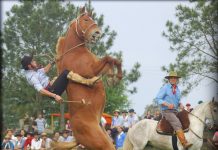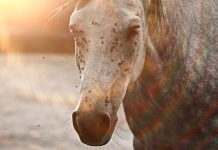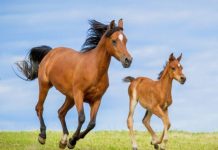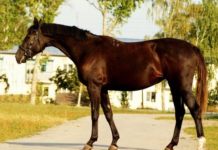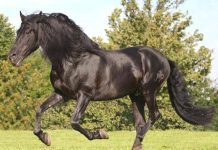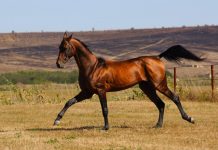Are you interested in the Highland Pony horse breed? On this page, we offer you all the information you need to know about these unique and rare ponies from the Scottish highlands.
Breed description

The Highland Pony is one of the strongest British pony breeds. It has a stable physique and is very versatile.
The sturdy pony measures 132 to 148 cm in height and is the result of an ancient Scottish natural breed.
His proud head posture and his surefootedness in the field should be emphasized.
Size: 132 – 148 cm
Weight: 450 – 600 kg
Origin: Scotland
Lifespan: 25-30 years
Color: Almost all colors represented. Predominantly fawn, piebalds are not allowed
Suitable as: Leisure time, therapy
Origin and breed history
It comes from the poorly forested heather heights of northwest Scotland.
Here, on the barren mountain ranges, the very robust and also ideally adapted to adverse weather conditions, the Highland Pony developed into an ideal companion for humans.
It is assumed that this breed was already present in the times of the Celts and, subsequently, of the Scottish Picten. There are sandstone reliefs from the Middle Ages showing small horses that are very similar to the Highland Pony.
They were used by the nobility as well as by the peasants. Their use was very varied and ranged from the riding horse to the load and work pony to the war effort of the clansmen.
With the agile Highland Pony long distances could be covered in rough terrain. The pony breed is therefore still suitable today for trail riding and trekking.
The Highland Pony has therefore been used as a trekking pony in the Scottish Highlands since 1952.
At the end of the 19th century, the English nobility discovered these ponies for deer and grouse hunting, so that the pony breed could be saved from the slow extinction.
Breeding and breed history
The small, powerful ponies served peasants and nobility alike. Although small, adults can ride them too. They can also carry heavy loads over long distances.
When the Scottish highlands were subjected to a massive policy of repression by the English crown in the 18th century, the once-proud population of 8,000 animals threatened to decimate badly around 1750.
It was not until the end of the 19th century that the Highland Pony began to be bred systematically. These ponies had previously been crossed by heavy horse breeds from France at the beginning of the 16th century and later with noble Spanish and Oriental stallions.
This brought a refinement and refinement into the breed without significantly changing the primeval character.
At the end of the 19th century, stud farms were established to ensure the preservation of the Highland Pony. From 1898 the Hackney, Clydesdale and Arabian breeds were used as breeding stallions.
Pure-blooded Highland stallions were used at the Knocknagael Stud on the Isle of Kye. The first studbook performances have been there since the end of the 19th century.
In 1923 the Highland Pony Society was founded, whose patron and most famous breeder is Queen Elisabeth II, which keeps around 400 Highland ponies at Balmoral Castle.
The Highland Pony Society has kept the stud book since 1960. Highland ponies have been known in Germany since the 1990s. In 1987 the first mare was imported and in 1990 the stallion Duart of Glenmuick for breeding.
In 1993 the German breeders joined together to form an interest group. Worldwide, the population of Highland ponies is only 4,000 horses.
They are very popular as riding and therapy ponies and for equestrian sports. However, since they were mainly used in agriculture for centuries, they are now critically endangered, including in Scotland.
A rare, rare and unique breed of pony. It has been classified as an Endangered Breed by the Rare Breed Survival Trust.
The appearance of the Highland ponies
The strong and friendly ponies have a pretty appearance. A proud head posture, a watchful and trusting eye and a strong build characterize a Highland Pony.
The color of the fur is mostly fawn, from gray to mouse gray, but flax and cream-colored ponies are also common.
Pure-blooded breed ponies are also characterized by the characteristic eel line, a shoulder cross and zebra stripes on the legs. But there are also dark foxes with silvery long hair, as well as molds and black-brown foxes.
Foals change their fur. There can also be differences in winter and summer fur. They reach an average height of 145 cm.
The physique is compact and harmonious, with well-sloped shoulders and a deep chest, well-arched ribs and plenty of room for the heart and lungs.
The long hair on the mane and tail is naturally plump. The droppings are soft and silky. Other body characteristics to be emphasized are the muscular hindquarters, a strong carpal joint and dark, hard and well-formed hooves.
The nostrils are wide and the mouth is large. The neck is not too short and also muscular. The strong foundation shows dry, flat bones and a short cannon bone.
Due to their breed, they are very sure-footed and are therefore also suitable for beginners. In the terrain they are walking freely, while being soft in movement.
They are persistent at the trot and energetic at the gallop. They show talent for jumping.
Temperament and essence
The ponies have been used to people for centuries. An animal whose character you can rely on! They show a balanced and gentle nature, but also have a lively temperament.
They are really ideal for riding, as pack horses and workhorses. They are persistent and undemanding, which is also reflected in their temperament.
A Highland Pony doesn’t get upset that quickly, it shows strong nerves and calm.
That is why it is also the ideal family pony. A Highland Pony can also be used for therapeutic riding.
Husbandry and nutrition

Attitude
This pony breed is used to hardships and adverse weather conditions, so you can keep the pony outside all year round. However, an open stable would be ideal, especially in snow and ice.
Nutrition
Due to its breed, it is used to barren heathland and rough winds in the Scottish highlands. There is therefore no need for lush, fertile pastures and certainly no concentrated feed.
Otherwise, the bangs will be too thick. But you should make sure that your pony has company. Ponies are herd animals that cannot do without them.
A Highland Pony also gets along very well with other pets such as a donkey, cat or dog. In winter it is sufficient to feed them with hay and straw.
Education and care
Upbringing
Stable upbringing is part of the keeping. With the uncomplicated Highland Pony this will certainly not be difficult for you. As you get used to it, note that it will take some time for your pony to really trust you.
You should try to work daily to help your pony get used to the new environment.
Maintenance
Of course, your pony will be happy about proper care. Regular grooming and brushing, especially in summer, and when your Highland Pony loses its winter coat, is advisable.
Children in particular also enjoy combing their long mane and tail.
Health and Typical Diseases
The Highland Pony has no diseases typical of the breed. If the conditions are appropriate to the species, this pony breed really proves to be very robust and resilient.
There are no known hereditary diseases. But of course, like all horses, you should protect your pony from moisture on the hooves, drafts, sugar, and rotten food.
Life expectancy
When kept in a species-appropriate manner, the Highland Pony can live for a long time. Ponies can generally live up to 40 years
Buy Highland Pony horse breed
You can buy a Highland Pony directly from the breeder. Inquire directly from the IG Highland Pony Association “Der Clan” e.V. in Germany or from breeders in Scotland.
However, a transfer from Scotland is associated with immensely high costs. Since there are also breeders of Highland ponies in Lower Saxony, Hesse, and Schleswig-Holstein, it is certainly easier to view and purchase them on site.
In addition, the Highland Pony Breed Show, which is carried out by the German breeders’ association, takes place every two years. The prices for a Highland Pony vary considerably.
Of course, it depends on parentage, age, and appearance.
But you can be sure that you will always get a thoroughbred Highland pony, all Highland ponies, including those bred abroad, must be traced back to the studbook that has existed since 1890.
Of course, you can also buy a Highland Pony privately. They are offered both on the internet and at special horse markets. The price for a Highland Pony ranges from $1,900 to $12,000.
Decision support

When you choose a Highland Pony, you are making a friend for life. This pony breed is extremely strong, patient, and good-natured.
So the ideal family pony. You are very used to working and dealing with people. It is also very suitable for equestrian sports. Take a look at other types of pony to help you decide. How about the Percheron, New Forest Pony, or the Hackney Pony?
Of course, a young pony must first be trained and broken in, but this is generally not a problem. A Highland Pony is not only strong and handsome but is also quick to grasp.
In addition to dogs, horses are ideal companions for humans. They reward the loving attitude with loyalty and devotion. Animals and humans can learn a lot from each other. The Highland Pony is a good choice!








